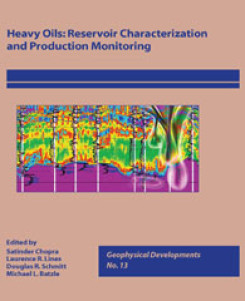Heavy Oils: Reservoir Characterization and Production Monitoring
Heavy Oils: Reservoir Characterization and Production Monitoring, edited by Chopra, Lines, Schmitt, and Batzle, presents an integrated and general description of the development and production of heavy oil fields throughout the world, with particular emphasis on geophysical characterization of heavy oil fields. The book (SEG Geophysical Developments Series No. 13) introduces the important economic impact of heavy oil as a major world energy resource, with reserves being roughly equivalent to the world's conventional oil reserves. The origin of heavy oil sands, its phase behavior, and unique physical properties are described in the context of the world's major heavy oil fields. Particular attention is paid to the unique rock physics of heavy oil sands, which offers challenges to the conventional theories that describe fluid-saturated sandstones. Given the high viscosity and density of this oil, there are distinct challenges to production. This book edited by Chopra et al. describes a wide range of enhanced oil recovery methods (EOR) including steam injection, solvent injection, cold production, and combustion. In all these EOR methods, it is imperative to accurately describe the reservoir before and after production. As pointed out by the book, this reservoir characterization requires integration of engineering, geology, and geophysics, with rock physics supplying a key link. The book emphasizes geophysical methods, especially time-lapse 3D seismic methods, while providing numerous case histories from the 2007 SEG Development and Production Workshop at the University of Alberta. The heavy oil geology and production from major heavy oil reservoirs is compared and contrasted. Given the economic importance and need for detailed information about heavy oil production, this book should prove interesting to all reservoir engineers, geologists, and geophysicists in this field.
- Genre: All Books, Unconventional
Cast & Characters
| 1-69 | Heavy-Oil Reservoirs: Their Characterization and Production |
| 73-80 | Seismic Properties of Heavy Oils — Measured Data |
| 81-87 | Modeling Studies of Heavy Oil — In between Solid and Fluid Properties |
| 89-97 | Correlating the Chemical and Physical Properties of a Set of Heavy Oils from around the World |
| 99-105 | Measuring and Monitoring Heavy-Oil Reservoir Properties |
| 107-112 | Seismic Rock Physics of Steam Injection in Bituminous-Oil Reservoirs |
| 113-119 | Prediction of Pore Fluid Viscosity Effects on P-Wave Attenuation in Reservoir Sandstones |
| 121-217 | Elastic Property Changes in a Bitumen Reservoir during Steam Injection |
| 131-154 | The Devonian Petroleum System of the Western Canada Sedimentary Basin — with Implications for Heavy-Oil Reservoir Geology |
| 155-163 | Review of Geology of a Giant Carbonate Bitumen Reservoir, Grosmont Formation, Saleski, Alberta |
| 165-171 | Deterministic Mapping of Reservoir Heterogeneity in Athabasca Oil Sands Using Surface Seismic Data |
| 173-181 | Imaging Oil-Sands Reservoir Heterogeneities Using Wide-Angle Prestack Seismic Inversion |
| 183-190 | Characterization of Heavy-Oil Reservoir Using VP / VS Ratio and Neural Networks Analysis |
| 191-200 | Multicomponent Processing of Seismic Data at the Jackfish Heavy-Oil Project, Alberta |
| 203-214 | Geostatistical Reservoir Modeling Focusing on the Effect of Mudstone Clasts on Permeability for the Steam-Assisted Gravity Drainage Process in the Athabasca Oil Sands |
| 215-226 | Monitoring an Oil-Sands Reservoir in Northeast Alberta Using Time-Lapse 3D Seismic and 3D P-SV Converted-Wave Data |
| 227-234 | Oil-Sands Reservoir Characterization for Optimization of Field Development |
| 237-241 | The Effects of Cold Production on Seismic Response |
| 243-249 | Effects of Heavy-Oil Cold Production on VP/VS Ratio |
| 251-257 | Collaborative Methods in Enhanced Cold Heavy-Oil Production |
| 259-263 | Crosswell Seismic Imaging — A Critical Tool for Thermal Projects |
| 265-273 | The Impact of Oil Viscosity Heterogeneity on Production from Heavy Oil and Bitumen Reservoirs: Geotailoring Recovery Processes to Compositionally Graded Reservoirs |
| 275-284 | Using Time-Lapse Seismic to Monitor the Toe-to-Heel-Air-Injection (THAI™) Heavy-Oil Production Process |
| 287-291 | Geomechanics Effects in Thermal Processes for Heavy-Oil Exploitation |
| 293-300 | Passive Seismic and Surface Monitoring of Geomechanical Deformation Associated with Steam Injection |
| 301-307 | 2Using Multitransient Electromagnetic Surveys to Characterize Oil Sands and Monitor Steam-Assisted Gravity Drainage |
| 311-313 | Tar Sands: Key Geologic Risks and Opportunities |

